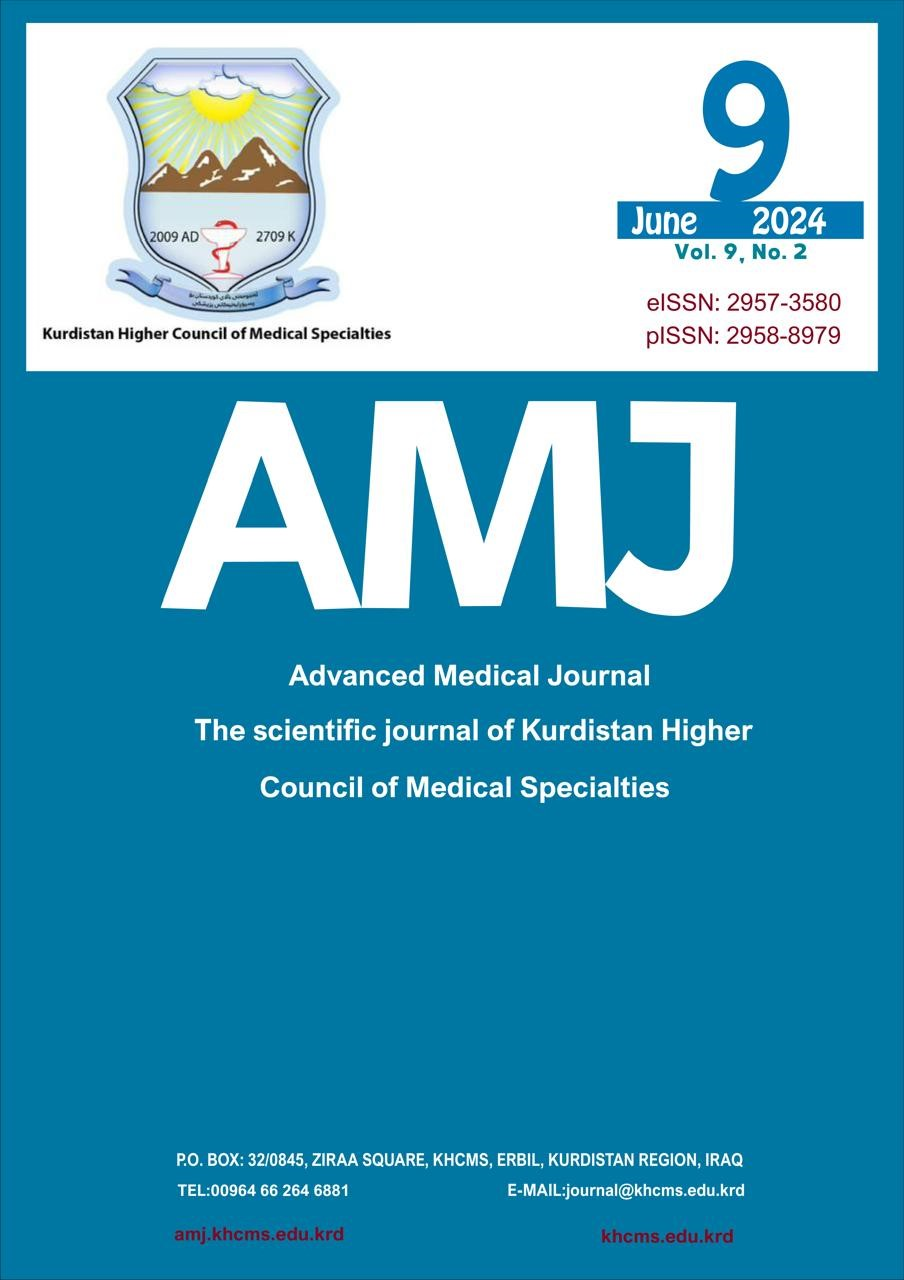Factors affecting the success and perioperative complications of retrograde intrarenal surgery: a retrospective clinical analysis
DOI:
https://doi.org/10.56056/amj.2024.256Keywords:
Flexible ureteroscopy lithotripsy, Renal stone disease, RIRS, Retrograde intrarenal surgeryAbstract
Background and objective:
Many factors are presumed to have an impact on the results of retrograde intra renal surgery. In the current study, our objective was to actuate the possible factors influencing the stone-free rates and complications post lone-session retrograde intrarenal surgery for renal calculi. Stone-free rates
Methods: Overall 200 patients who undergone retrograde intra renal surgery between January 2019 and March 2022 were evaluated, retrospectively. Success was decided if there were no residual fragments on pain X-ray and ultrasonography. Patient demographics, stone characteristics, perioperative data were assessed and analyzed to actuate predictive factors influencing stone-free rates and perioperative morbidities.
Results: Two hundred patients with a mean age of 41.12±14.37 years were evaluated. The mean stone size was 1.815 ± 2.107 millimeters (mm), mean stone density was 969.63 ± 345.307 Hounsfield unit. The immediate SFR was (76.8±0.42) while the final SFR (single session) was 87.9±0.46. Thirty-seven patients (18.5%) developed complications, the preponderance of them 86% were minor complications (Clavien grade I and II). In multivariate regression analysis, multiple renal stones and ureteral access sheath use were constitute to be statically significant predictors of stone-free status. Moreover, multivariate regression analysis revealed that operative time, lasing time and stone opacity stones were statistically significant factors influencing perioperative complications.
Conclusion: Success rates inversely related to stones number and ureteral access sheath usage. While prolonged operation time, lasing time, and higher stone density could be a more reliable predictor of perioperative complication development.
Downloads
References
Dai JC, Pearle MS. Diet and Stone Disease in 2022. J Clin Med. 2022; 11(16):4740.
Marshall VF. Fiber optics in urology. J Urol. 1964; 91:110-4.
Grasso M, Bagley D. Small diameter, actively deflectable, flexible ureteropyeloscopy. J Urol. 1998; 160(5):1648-53.
Assimos D, Krambeck A, Miller NL, et al. Surgical Management of Stones: American Urological Association/Endourological Society Guideline, PART I. J Urol. 2016; 196(4):1153-60.
Turk C, Petrik A, Sarica K, et al, Guidelines EAU. On interventional treatment for Urolithiasis. Eur Urol.2016; 69(3):475–82.
Hesse A, Brändle E, Wilbert D, Köhrmann K, Alken P. Study on the prevalence and incidence of urolithiasis in Germany comparing the years 1979 vs. 2000. Eur Urol. 2003; 44(6):709-13. Available from: doi: 10.1016/s0302-2838(03)00415-9.
Scales CD, Smith AC, Hanley JM, Saigal CS. Prevalence of Kidney Stones in the United States. Eur Urol 2012; 62(1):160-52012; 62:160–5.
Akar EC, Knudsen BE. Flexible ureteroscopy versus percutaneous nephrolithotomy as primary treatment for renal stones 2 cm or greater. Reports Med Imaging. 2013; 6(1):1–10.
Pan J, Chen Q, Xue W, et al. RIRS versus MPCNL for single renal stone of 2–3 cm: clinical outcome and cost-effective analysis in Chinese medical setting. Urolithiasis. 2013; 41(1):73–8.
Mahmood SN, Babarasul MH, Fakhralddin SS, Tawfeeq HM. Retrograde intrarenal surgery for the treatment of renal stones in patients with a solitary kidney: Does access sheath matter? African J Urol. 2021; 27(1).
Alazaby H, Khalil M, Omar R, et al. Outcome of retrograde flexible ureterorenoscopy and laser lithotripsy for treatment of multiple renal stones. African J Urol. 2018; 24(2):146–51.
Zeng G, Zhao Z, Yang F, Zhong W, Wu W, Chen W. Retrograde intrarenal surgery with combined spinal-epidural vs general anesthesia: A prospective randomized controlled trial. J Endourol. 2015; 29(4):401–5.
Lim SH, Jeong BC, Seo S Il, Jeon SS, Han DH. Treatment outcomes of retrograde intrarenal surgery for renal stones and predictive factors of stone-free. Korean J Urol. 2010; 51(11):777–82.
Ho CC, Hee TG, Hong GE, Singam P, Bahadzor B, Zainuddin ZM. Outcomes and safety of retrograde intra-renal surgery for renal stones less than 2 cm in size. Nephrourol Mon. 2012; 4(2):454–7.
Abd El Hamed AM, Elmoghazy H, Aldahshoury M, et al. Single session vs two sessions of flexible ureterosopy (FURS) for dusting of renal pelvic stones 2-3 cm in diameter: Does stone size or hardness play a role in number of sessions to be applied? Turk Urol Derg. 2017; 43(2):158–61.
Kahraman O, Dogan HS, Asci A, Asi T, Haberal HB, Tekgul S. Factors associated with the stone-free status after retrograde intrarenal surgery in children. Int J Clin Pract. 2021; 75(10):1–6.
Ito H, Kawahara T, Terao H, et al. Predictive value of attenuation coefficients measured as hounsfield units on noncontrast computed tomography during flexible ureteroscopy with holmium laser lithotripsy: A single-center experience. J Endourol. 2012; 26(9):1125–30.
Tonyal, Y lmaz M, Karaaslan M, Ceylan C, Ikay L. Prediction of stone-free status after single-session retrograde intrarenal surgery for renal stones. Turk J Urol. 2018; 44(6):473-477.
Perlmutter AE, Talug C, Tarry WF, Zaslau S, Mohseni H, Kandzari SJ. Impact of Stone Location on Success Rates of Endoscopic Lithotripsy for Nephrolithiasis. Urology. 2008; 71(2):214–7.
Tonyal, Ylmaz M, Karaaslan M, Ceylan C, Ikay L. Prediction of stone-free status after single-session retrograde intrarenal surgery for renal stones. Turkish J Urol. 2018; 44(6):473–7.
Tastemur S, Senel S, Kizilkan Y, Ozden C. Evaluation of the anatomical factors affecting the success of retrograde intrarenal surgery for isolated lower pole kidney stones. Urolithiasis. 2022; 50(1):65–70.
Sari S, Caniklioglu M, Oztekin Ü, Selmi V, Taspinar MS, Isikay L. Factors Affecting Retrograde Intrarenal Surgery Success: 6 Years’ Experience of a Clinic in Central Anatolia. J Laparoendosc Adv Surg Tech. 2020; 30(12):1340–3.
Karim SS, Hanna L, Geraghty R, Somani BK. Role of pelvicalyceal anatomy in the outcomes of retrograde intrarenal surgery (RIRS) for lower pole stones: outcomes with a systematic review of literature. Urolithiasis. 2020; 48(3):263–70.
Jeong JY, Kim JC, Kang DH, Lee JY. Digital videoscopic retrograde intrarenal surgeries for renal stones: Time-to-maximal stone length ratio analysis. Yonsei Med J. 2018; 59(2):303–9.
Chu L, Sternberg KM, Averch TD. Preoperative stenting decreases operative time and reoperative rates of ureteroscopy. J Endourol. 2011; 25(5):751–4.
Sung LH, Cho DY. The role of preoperative ureteral stenting in retrograde intrarenal surgery in renal stone patients: A propensity score-matched study. Transl Androl Urol. 2020; 9(2):276–83.
Shields JM, Bird VG, Graves R, Gómez-marín O. Impact of Preoperative Ureteral
Stenting on Outcome of Ureteroscopic Treatment for Urinary Lithiasis. J UROL. 2009; 182(6):2768–74.
De La Rosette J, Denstedt J, Geavlete P, et al. The clinical research office of the endourological society ureteroscopy global study: Indications, complications, and outcomes in 11,885 patients. J Endourol. 2014; 28(2):131–9.
Breda A, Angerri O. Retrograde intrarenal surgery for kidney stones larger than 2.5cm. Curr Opin Urol. 2014; 24(2):179–83.
Berardinelli F, Proietti S, Cindolo L, et al. A prospective multicenter European study on flexible ureterorenoscopy for the management of renal stone. Int Braz J Urol. 2016; 42(3):479–86.
Niwa N, Matsumoto K, Ohigashi T, et al. Clinical Outcomes of Retrograde Intrarenal Surgery as a Primary Treatment for Staghorn Calculi: A Single-Center Experience. Clin Med Insights Urol. 2019; 12:117956111985477.
Degirmenci T, Yar?mo S. Factor’s affecting intraoperative and postoperative complications of RIRS classified by the Clavien and Satava grading systems. 2021; 1–8. Available from: DOI:10.22541/au.161590005.56042638/v1/
Zhang H, Jiang T, Gao R, et al. Risk factors of infectious complications after retrograde intrarenal surgery: a retrospective clinical analysis. J Int Med Res. 2020; 48(9):4–12.
Doan HS, ahin A, Çetinkaya Y, Akdoan B, Özden E, Kendi S. Antibiotic prophylaxis in percutaneous nephrolithotomy: Prospective study in 81 patients. J Endourol. 2002; 16(9):649–53.
Senel S, Ozden C, Aslan Y, Kizilkan Y, Gokkaya CS, Aktas BK. Can the Stone Scoring Systems Be Used to Predict Infective Complications of Retrograde Intrarenal Surgery? Med Princ Pract. 2022; 31(3):231–7.
Downloads
Published
How to Cite
Issue
Section
License
Copyright (c) 2024 Sarwar Noori Mahmood, Dler Fathulla Abdalla, Choman Jamal Ahmed

This work is licensed under a Creative Commons Attribution-NonCommercial-ShareAlike 4.0 International License.
The copyright on any article published in AMJ (The Scientific Journal of Kurdistan Higher Council of Medical Specialties )is retained by the author(s) in agreement with the Creative Commons Attribution Non-Commercial ShareAlike License (CC BY-NC-SA 4.0)









